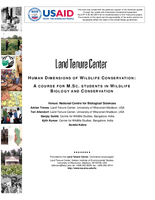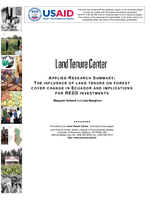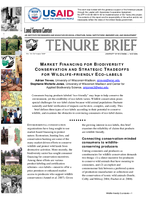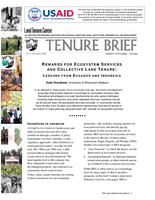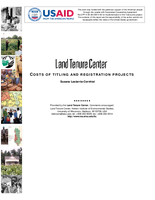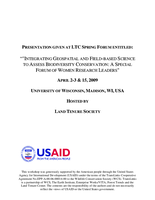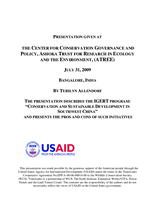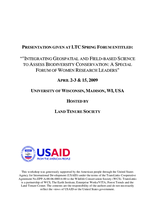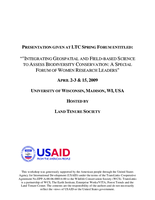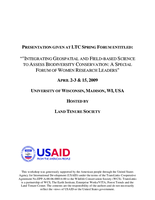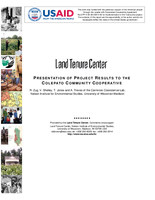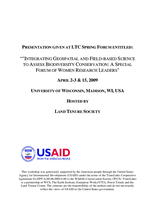Land Tenure Center

Human Dimensions of Wildlife Conservation: A course for M.Sc. students in Wildlife Biology and Conservation
Conservation of endangered species such as tigers and Asian elephants demands that we balance wildlife and human needs. To achieve this balance, each generation of wildlife conservation workers must understand ecological factors as well as sociopolitical and economic ones.
Integrating Geospatial and Field-based Science to Assess Biodiversity Conservation: A Special Forum of Women Research Leaders
Flyer: Integrating Geospatial and Field-based Science to Assess Biodiversity Conservation: A Special Forum of Women Research Leaders
Agencies, Donors and NGOs Interviewed By LTC Team in Ecuador
List of Agencies, Donors and NGOs Interviewed By LTC Team in Ecuador
Collaborative Planning for Land Use: Zoning for Conservation and Development in Protected Areas - SPANISH
Collaborative Planning for Land Use: Zoning for Conservation and Development in Protected Areas
Identifying a potential lion Panthera leo stronghold in Queen Elizabeth National Park, Uganda, and Parc National des Virunga, Democratic Republic of Congo
Confirming if threats to lions are severe or lion populations are disappearing requires extensive surveys on the ground because aerial detection of lions is inaccurate. Abstract Conservationists are raising concerns over high lion Panthera leo mortality and prey population declines in the area at the frontier between the Democratic Republic of Congo and Uganda. Confirming if threats to lions are severe or lion populations are disappearing requires extensive surveys on the ground because aerial detection of lions is inaccurate. Yet, ground surveys over large areas are unsafe or infeasible in the war-torn study area. We used aerial surveys of medium- to large-bodied ungulate prey to estimate lion abundance in two adjoining parks: Queen Elizabeth National Park, Uganda, and Parc National des Virunga, Democratic Republic of Congo. We validated two approaches to predict lion abundance using total counts of lions from Uganda. From this, we predict the two national parks together could have held 221 lions in 2004 and they have the potential to hold 905 lions if prey recover and lion-specific mortality is curbed. This makes the region a potential stronghold for the species in central Africa. However, a recent one third decline in lion numbers in the Ugandan Park and pervasive threats to the Congolese Park lead us to recommend immediate conservation intervention for lions and their prey. In Uganda, we recommend focused action to protect lions from poaching and retaliation, whereas in Congo, general enforcement of wildlife protection and a ground-based survey for lions are needed
Applied Research Summary: The influence of land tenure on forest cover change in Ecuador and implications for REDD investments
The influence of land tenure on forest cover change in Ecuador and implications for REDD investments
Market Financing for Biodiversity Conservation and Strategic Tradeoffs for Wildlife-friendly Eco-labels
Market Financing for Biodiversity Conservation and Strategic Tradeoffs for Wildlife-friendly Eco-labels
Rewards for Ecosystem Services and Collective Land Tenure: Lessons from Ecuador and Indonesia
Attempts to conserve biodiversity and other ecosystem services have been carried out through a number of policy instruments over time
Costs of Titling and Registration Projects
Neo-liberal economic theory is based on the foundation of private property and the market. Private property is the only to make sure that property ends up in the hands of the most efficient producers. And, a property system based on private and individual property rights makes the transactions of property and land (the land market) efficient. With this in mind, donor agencies since the 1980s have promoted and funded the creation of private property land markets in developing countries.
Predicting climate change impacts on biodiversity in Tropical Andes
Presentation given at LTC spring forum entitled: "Integrating Geospatial and Field-based Science to Assess Biodiversity Conservation: a Special Forum of Women Research Leaders" April 2-3 & 15, 2009
Training graduate students to understand sustainable development and biodiversity conservation over a landscape in northwest Yunnan, China
The presentation describes the IGERT program: “Conservation and Sustainable Development in Southwest China” and presents the pros and cons of such initiatives
Land Use Transitions and Ecosystem Services in Tropical Forests
Presentation given at LTC spring forum entitled: "Integrating Geospatial and Field-based Science to Assess Biodiversity Conservation: a Special Forum of Women Research Leaders" April 2-3 & 15, 2009
The Shrinking Ark Large Mammal Extinctions in India
Presentation given at LTC spring forum entitled: "Integrating Geospatial and Field-based Science to Assess Biodiversity Conservation: a Special Forum of Women Research Leaders" April 2-3 & 15, 2009
Poverty Traps, Safety Nets or Development Magnets: Modeling the Influence of Costa Rican Parks on Human Welfare over Time
Presentation given at LTC spring forum entitled: "Integrating Geospatial and Field-based Science to Assess Biodiversity Conservation: a Special Forum of Women Research Leaders" April 2-3 & 15, 2009
Presentation of Project Results to the Colepato Community Cooperative
On May 31, 2009, we returned to the Colepato community to present the results from the 2008 Andean bear camera trap study. The goals of this meeting were to (1) share the results in a way that was meaningful to the community and beneficial to current and future conservation projects, (2) compare the results of species diversity with their knowledge of the wildlife on their property, and (3) to ask permission to continue Andean bear research on their land.
Seeking sustainability in the Amazon: Shifting from Brazil nut exploitation to conscious management
Presentation given at LTC spring forum entitled: "Integrating Geospatial and Field-based Science to Assess Biodiversity Conservation: a Special Forum of Women Research Leaders" April 2-3 & 15, 2009
Tropical Land-use Change Consequences for Biodiversity and Carbon
Presentation given at LTC spring forum entitled: "Integrating Geospatial and Field-based Science to Assess Biodiversity Conservation: a Special Forum of Women Research Leaders"
Report on Wildlife Friendly monitoring and verification project, Ecuador 2009
2009 Report on Wildlife Friendly monitoring and verification project, Ecuador


